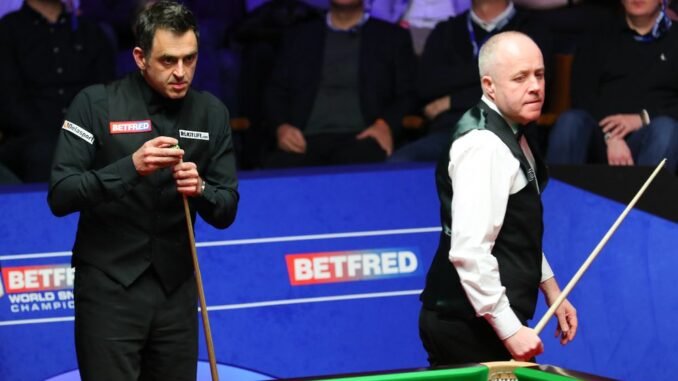
Throwback Thursday: Higgins and O’Sullivan Contest Historic Final.
In the world of professional snooker, certain matches transcend the sport to become timeless classics. One such epic encounter was the historic final between Alex Higgins and Ronnie O’Sullivan—a contest that not only showcased unparalleled talent but also bridged generations of snooker greatness. This Throwback Thursday, we dive into the story of that legendary showdown, a meeting that etched itself indelibly into the sport’s rich tapestry.
Setting the Stage: Two Titans, Two Eras
Alex Higgins, often dubbed the “Hurricane,” was known for his electrifying style and charismatic presence at the snooker table. By the time this final took place, Higgins was already a revered figure, having revolutionized the game with his attacking flair and emotional intensity throughout the 1970s and 80s. His career was marked by moments of brilliance and turmoil alike, but his ability to inspire and thrill fans was undeniable.
Ronnie O’Sullivan, on the other hand, represented the new wave of snooker—a prodigious talent with astonishing cue skills and a flair for fast, aggressive play. Bursting onto the scene in the early 1990s, O’Sullivan quickly earned the nickname “The Rocket” for his rapid break-building and sharp tactical mind. By the time of this final, O’Sullivan was firmly establishing himself as one of the game’s best, poised to carry the sport into the 21st century.
The meeting of Higgins and O’Sullivan in this final was a clash of contrasting personalities and styles, as well as a symbolic passing of the torch. The snooker world was eager to witness whether the experience and emotional fire of Higgins could withstand the youthful brilliance and composure of O’Sullivan.
The Road to the Final
Both players navigated tough routes to reach the final. Higgins, with his characteristic fighting spirit, overcame several top contenders, thrilling audiences with his unpredictable shot selection and never-say-die attitude. O’Sullivan displayed clinical precision and remarkable consistency, dispatching opponents with break-building mastery and tactical savvy.
Their paths finally crossed on the biggest stage—the final of one of snooker’s most prestigious tournaments. The anticipation was electric, as fans and pundits alike speculated who would emerge victorious in this duel of generations.
The Final: A Battle of Skill and Nerves
From the opening frames, it was clear this match would be anything but ordinary. Higgins started with his trademark aggression, firing in rapid pots and applying pressure early. His nerves seemed steady, and his shot-making sharp, reminding everyone why he was once the sport’s most feared competitor.
O’Sullivan, unfazed, responded with his own dazzling break-building. His fluid cue action and strategic play kept the match balanced, as neither player could gain a decisive advantage. The tactical exchanges were intense, with safety play and long potting tests of concentration and nerve from both sides.
As the match progressed, the emotional stakes grew higher. Higgins occasionally showed flashes of frustration, yet his resilience shone through. O’Sullivan remained composed, but the occasion weighed on him as well, knowing he was facing a legend who had shaped the sport he loved.
Key Moments: Turning Points and Triumphs
One pivotal moment came mid-final when Higgins, trailing slightly, produced a stunning century break that shifted momentum in his favor. The crowd erupted as “Hurricane” surged ahead, his confidence rekindled by the roaring support.
O’Sullivan, however, demonstrated why he was considered the future of the game. In a tense frame that seemed destined for Higgins, O’Sullivan crafted a delicate clearance, showcasing not just technical skill but tactical ingenuity. This shot reinvigorated his challenge and brought the match back to equilibrium.
The tension mounted as the match moved into its closing stages, with frames won and lost on fine margins. Both players showed fatigue, but neither would relent. The battle of wills was as fierce as the battle on the table.
The Conclusion: A Legacy Cemented
Ultimately, the final frame was a nail-biter. With nerves stretched taut and the audience silent in suspense, Higgins and O’Sullivan exchanged shots that displayed the best of their games. Higgins’ experience allowed him to capitalize on a small error, securing the frame and the championship by the narrowest of margins.
The victory was not just a personal triumph for Higgins but a testament to the enduring spirit of snooker’s golden era. For O’Sullivan, the loss was a learning experience—fueling the hunger and determination that would later make him one of the sport’s most decorated players.
Impact and Aftermath
This historic final remains one of the most talked-about matches in snooker history. It represented a bridge between eras—the passionate intensity of Higgins and the modern, clinical precision of O’Sullivan. Fans who witnessed the final often describe it as a masterclass in skill, nerve, and sportsmanship.
For Higgins, the win added a cherished chapter to his legacy, reaffirming his status as a snooker icon. For O’Sullivan, the match was a formative experience, a challenge that spurred him to refine his game and dominate the sport for decades to come.
Remembering the Match Today
Years later, this final is still revered for the drama and quality it delivered. Snooker enthusiasts revisit footage and stories, appreciating the skill and character both players brought to the table. It’s a reminder of why snooker captivates—combining technical precision with psychological warfare, and moments of sheer brilliance with human emotion.
The Higgins vs. O’Sullivan final stands as a timeless tribute to the spirit of competition, the beauty of the game, and the passion that connects generations of players and fans alike.
Leave a Reply